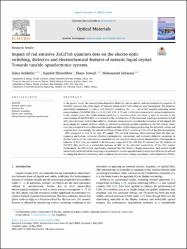Impact of red emissive ZnCdTeS quantum dots on the electro-optic switching, dielectric and electrochemical features of nematic liquid crystal: Towards tunable optoelectronic systems
Abstract
In the present study, the concentration-dependent dielectric, electro-optical, and electrochemical properties of ZnCdTeS quantum dots (QDs) doped E7 nematic liquid crystal (NLC) mixtures were investigated. The dielectric permittivity components (epsilon(parallel to) and epsilon(perpendicular to)) and dielectric anisotropy (Delta epsilon -epsilon(parallel to) - epsilon perpendicular to.) of NLC samples containing varied concentrations of ZnCdTeS QDs (i. e. 0.10, 0.25, 0.50, 0.75, and 1 wt%) were measured at various temperatures. In the nematic phase, the results demonstrated that e. increases much more than epsilon(perpendicular to) upon an increase in the concentration of ZnCdTeS QDs. Delta epsilon enhanced as the concentration of QDs increased, reaching a maximum at 0.50 wt%, then decreased with further addition. Dielectric measurements revealed the formation of self-aligned QD arrays along the nematic director, which act similarly to multiple parallel capacitors in the NLC system. Moreover, electro-optical studies illustrated the significant effect of QDs doping on lowering the threshold voltage and response time. Interestingly, the optical switching-off time of NLC containing 0.50 wt% of the QDs decreased by similar to 50% compared to that of the pure E7 sample. The reduced screening effect resulting from the QDs ioncapturing mechanism, enhanced effective intermolecular interactions, and increased dielectric anisotropy in the NLC system are the major factors responsible for the improved electro-optical characteristics. The impedance behavior of NLC cells was studied in the frequency range of 0.1 Hz-100 kHz. It indicated that the addition of ZnCdTeS QDs results in a remarkable increase of 96% in the electrical conductivity of the NLC system. Furthermore, the QDs doping significantly improved the NLC device's charge capacitance. Such studies would undoubtedly be beneficial for designing next-generation tunable optoelectronic systems since QDs can be utilized for tuning the dielectric anisotropy, electro-optical characteristics, charge capacitance, and conductivity of NLCs.


















